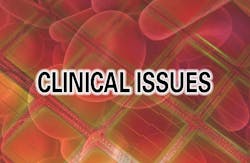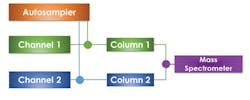Overcoming the analytical challenges of forensic laboratories
The process of identification, monitoring and quantitation of drugs is a crucial component of forensic investigations and clinical research. The increase in number of prescribed analgesics, misuse of opioids and recent attempts to bypass substance laws have overwhelmed the forensic community as laboratories experience ever-increasing caseloads and the need for certain critical technical upgrades.
To meet these demands, forensic scientists and clinical researchers will need robust, reproducible, reliable and sensitive methods to accurately identify and quantify new, unknown compounds, along with known compounds, as well as high-throughput technologies to keep up with the hundreds of samples arriving each day.
Keeping up with increasing demands
The forensic market is expected to grow at the rate of 7 percent annually.1 In a recent survey conducted with 400 forensic laboratories in the U.S., around 30 percent reported that caseloads were increasing year-on-year.1 This steep rise stems from an increase in the unlawful manufacturing and trafficking of new designer drugs, distributed either under a mislabeled name or made accessible online. To enable forensic laboratories to stay ahead in the fight against drug abuse, scientists will not only need reliable, sensitive, and robust technology to address the critical analytical challenges, but also technologies with higher-throughput capabilities that can process multiple samples in less time.
The rise in new drugs (also known as designer drugs) requires forensic laboratories to act quickly. Novel psychoactive substances (NPS) such as the opioid fentanyl, which is 50 times more potent than heroin, are being used by drug traffickers to lace diluted heroin. In March 2017, routine testing for NPS at the LGC laboratories in the UK detected the presence of carfentanil, an analog of fentanyl with 100X its potency, in a postmortem blood case.2 The minimal scientific information available on most of these new drugs has led to them being classified as “known unknowns” and can pose additional challenges to laboratories focused on identifying, monitoring and quantifying them. In fact, almost 60 percent of the surveyed forensic laboratories admitted that the influx of newly identified drugs was a major contributor to their backlog.1
With legal and regulatory changes regarding consumption of substances such as cannabis, once more universally considered illegal, forensic laboratories need to constantly optimize processes, develop and validate new methods and consider technology upgrades to meet these changing requirements. The rise in medicinal and recreational use of previously illegal drugs requires forensic scientists to continually comply with the newly established standards for “under the influence.”
Pressed for funding and staff training time, many laboratories continue to use time-consuming legacy methods that often fail to address the growing analytical challenges. Often, multiple orthogonal tests are performed to close a single case, increasing the time spent per case and adding to the backlog. To continue offering reliable results at a faster pace, laboratories need to stay updated with information on modern technologies that can advance forensic science quickly and cost effectively while meeting the increasing demands of scientific analysis.
Next-generation analytical technologies
Most forensic laboratories perform immunoassays, a well-established technique often employed to detect drug usage after consumption via drug screening methods.3 Although easy to use, immunoassays limit the scope of forensic toxicologists. For starters, the sensitivity of an immunoassay in determining traces of a drug depends on the quality of the antibody. Also, the number of available antibodies validated for forensic use limits the number of compounds that can be detected.
The hands-on nature of immunoassay workflows makes it challenging to increase sample throughput. Although immunoassay manufacturers offer multiplexing options, these are, again, dependent on the availability of specific antibodies. If a new drug emerges, current immunoassay options are no longer relevant, and method development for the new analyte can take up to a year. When a cold case reopens, scientists will need to reanalyze or repeat older experiments, adding more time to each case.
Limitations in conventional methods, such as immunoassays, have prompted illegal drug manufacturers to modify the chemical structure of synthetic designer drugs so that they remain undetected even when tested, thereby bypassing the substance laws to continue illegal drug trafficking. Forensic laboratories need better technologies that can first, sustain the ever-changing nature of drug abuse and second, offer robust, adaptable methods that yield accurate results.
With the advent of next-generation technologies in forensics, liquid chromatography (LC) coupled with mass spectrometry (MS) has gained widespread popularity due to its higher analytical sensitivity and selectivity. Advanced MS technologies, namely, high-resolution, accurate mass (HRAM) mass spectrometry, help close the uncertainty gap in forensic analysis with reliable, accurate detection capabilities, confident unknown identification and detection of multiple analytes in a single experiment.
High resolution and mass accuracy are both important factors necessary to resolve the compound of interest from other analytes and complex biological matrices, even at low concentrations. Moreover, MS-based technologies enable retrospective analyses, i.e., if the data needs to be reassessed in the future, scientists can do so without repeating or reanalyzing the experiment.
Moreover, for laboratories aspiring to higher-throughput capabilities, LC-MS can be particularly beneficial, with its fast turnaround time (for every sample) and improved sensitivity. A university-based forensics laboratory, with a goal of staying self-supported and revenue neutral, made the switch from immunoassays to HRAM-based LC-MS after a thorough cost-recovery analysis. The lab, running almost 70,000 samples a year, got a return on investment within 18 months alongside the other added benefits of higher performance.1
Advanced technologies for current challenges
In order to address the ever expanding number of cases while monitoring, identifying and quantifying a growing list of new drugs that are constantly entering the market, forensic toxicologists need technologies that can screen compounds, detect unknowns and perform sensitive quantification in a fast-paced environment, ultimately helping to achieve the desired scientific and business goals. HRAM spectrometry can leverage a library or many libraries comprising thousands of reference compounds, and so enables researchers to quickly screen, identify and quantify substances with utmost confidence.
For example, using HRAM, toxicologists can screen and detect six common opiates in human urine—morphine, codeine, hydromorphone, hydrocodone, oxymorphone and oxycodone—even at low ng/mL levels, while meeting industry standards.4 With quintuplicate replicates of quality control over three different days and an assessment with 58 donor samples, this method demonstrates that forensic toxicologists can perform quantitation of specific panels of analytes to industry-established standards using MS-based methods.
HRAM-based methods also allow screening of known/unknown compounds with reliability and reproducibility. In one application, direct injection of urine into an ultra-high-performance liquid chromatography (UHPLC) system coupled with an Orbitrap high-resolution mass spectrometer was used to reliably screen for and identify 14 different fentanyl and fentanyl analogs.5 With an analysis time of only five minutes, all fentanyl compounds present in the spiked matrix were detected and confirmed at 0.5-5 ng/mL, validating the method for screening in clinical research or forensic toxicology.
After LGC laboratories first detected carfentanil, a fentanyl analog, they performed investigative MS-based analysis and established that carfentanil and its metabolites give highly diagnostic MS2 data.2 These findings resulted in a routine methodology to detect the new drug in both post-mortem blood and urine samples, even with limited knowledge about the drug’s metabolism. The LGC case study further validates the adaptability of next-generation analytical techniques, empowering forensic scientists to keep up with the ever-evolving landscape of drugs and future-proof their laboratories against changing regulations.
Conclusion
As illegal drug trafficking continues to rise, the use of prescribed drugs continues to grow, and the development and production of novel designer drugs continues to flourish, forensic laboratories shoulder the responsibility to stay updated with current regulations, offer technical capabilities to deal with the unknowns and, ultimately, play a key role in driving investigative decisions. Advances in MS technologies enable scientists to obtain unmatched resolution to accurately identify targeted and untargeted drugs with desired sensitivity and speed.
With the option to add multichanneling and the ability to perform retrospective analyses, LC-HRAM (MS) has expanded the scope of forensic analysis, enabling laboratories to develop new detection methods faster than ever before. By adopting these modern analytical technologies, forensic laboratories can significantly improve their efficiencies, ensure lower running costs and relieve the burden of increased caseloads. Most importantly, scientists can now confidently maintain assured certainty of results, especially when justice is on the line.
References:
- Removing Doubt in Forensic Science: Mass Spectrometry Workflows Solving Forensic Cases. Available at https://www.thermofisher.com/us/en/home/global/forms/industrial/removing-doubt-forensic-science-mass-spectrometry-workflows-solving-forensic-cases.html
- Designer Drugs that Kill and How to Detect Them. Available at https://www.lgcstandards.com/medias/sys_master/root/h97/h11/9616928571422/Designer-Fentanyls-Drugs-that-kill-and-how-to-detect-them-Cyclopropylfentanyl.pdf.
- An overview of forensic drug testing methods and their suitability for harm reduction point-of-care services. Available at https://www.ncbi.nlm.nih.gov/pmc/articles/PMC5537996/pdf/12954_2017_Article_179.pdf.
- Kristine Van Natta and Marta Kozak, Quantitation of Opiates to Low ng/mL Levels in Urine for Forensic Use Using an Affordable, High-Resolution, Accurate-Mass Mass Spectrometer. Available at https://assets.thermofisher.com/TFS-Assets/CMD/Application-Notes/AN-615-LC-Opiates-Urine-AN64257-EN.pdf.
- Magnus Olin and Magnus Olin, Uncovering Tracks – Robust, Reproducible Screening Assay for Fentanyls in Urine with LC-HRAM(MS) for Clinical Research or Forensic Toxicology. Available at https://assets.thermofisher.com/TFS-Assets/CMD/posters/po-73206-lc-hram-ms-fentanyls-urine-cr-ft-tiaft2019-po73206-en.pdf
About the Author

Debadeep Bhattacharyya, PhD
serves as Senior Marketing Manager for Clinical and Forensic Applications at Thermo Fisher Scientific. He has more than 12 years of experience working with mass spectrometers and other high-end analytical instruments, supporting customers across multiple industries and academic institutions. He holds a PhD in chemistry and biochemistry from Emory University.



